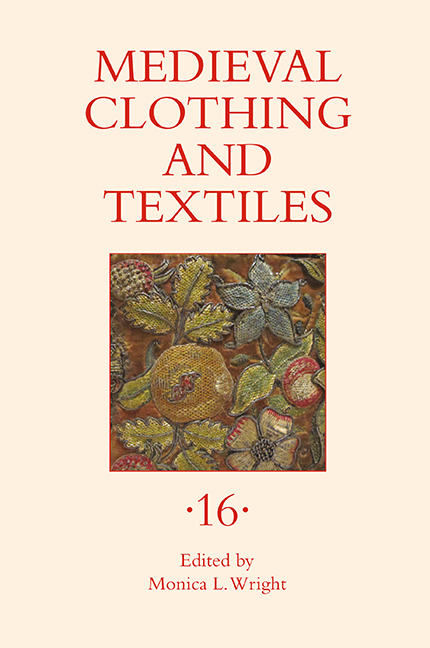Book contents
- Frontmatter
- Contents
- Illustrations
- Tables
- Contributors
- Preface
- 1 Anglo-Saxon Banners and Beowulf
- 2 The Use of Curved Templates in the Drawing of the Bayeux Tapestry
- 3 Construction and Reconstruction of the Past: The Medieval Nordic Textile Heritage of Hemp
- 4 Historicizing the Allegorical Eye: Reading Lady Mede
- 5 Sex, Lies, and Verdugados: Juana of Portugal and the Invention of Hoopskirts
- 6 Fashion and Material Culture in the Tabletop of the Seven Deadly Sins Attributed to Hieronymus Bosch
- 7 The Broderers’ Crown: The Examination and Reconstruction of a Sixteenth-Century City of London Livery Company Election Garland
- Appendix 7.1 Surviving Sixteenth-and Seventeenth-Century Embroidered Crowns of the City of London Livery Companies
- Recent Books of Interest
- Author Index, Volumes 1–15
Preface
Published online by Cambridge University Press: 27 March 2021
- Frontmatter
- Contents
- Illustrations
- Tables
- Contributors
- Preface
- 1 Anglo-Saxon Banners and Beowulf
- 2 The Use of Curved Templates in the Drawing of the Bayeux Tapestry
- 3 Construction and Reconstruction of the Past: The Medieval Nordic Textile Heritage of Hemp
- 4 Historicizing the Allegorical Eye: Reading Lady Mede
- 5 Sex, Lies, and Verdugados: Juana of Portugal and the Invention of Hoopskirts
- 6 Fashion and Material Culture in the Tabletop of the Seven Deadly Sins Attributed to Hieronymus Bosch
- 7 The Broderers’ Crown: The Examination and Reconstruction of a Sixteenth-Century City of London Livery Company Election Garland
- Appendix 7.1 Surviving Sixteenth-and Seventeenth-Century Embroidered Crowns of the City of London Livery Companies
- Recent Books of Interest
- Author Index, Volumes 1–15
Summary
Volume 16 continues this journal's tradition of publishing a wide range of studies from a variety of disciplines, and this particular volume boasts an unusually large number of images. The seven essays extend chronologically from the tenth through the sixteenth century and cover a wide geography: Scandinavia to Spain, with stops in England and the Low Countries.
M. Wendy Hennequin provides a detailed examination of lexical items for banners in the Old English Beowulf and argues that the prevalence of such terms in the poem attest to the cultural importance of banners for the society, as well as their poetic significance.
Maggie Kneen and Gale R. Owen-Crocker propose a fascinating new theory about the composition of the Bayeux Tapestry: They present evidence that multiple embroiderers used curved templates to draw the tapestry's design, which contributed to the uniform appearance.
Git Skoglund's essay opens a previously under-studied line of inquiry into the cultivation of hemp for textile production in medieval Scandinavia and provides an overview of conditions for and practices involved in growing hemp and its transformation into textiles.
By reading the character of Lady Mede (Piers Plowman) in the context of costume history, John Slefinger brings new depth to our understanding of her allegorical clothing and how fourteenth-century English authors used allegory generally.
By placing Spanish verdugados (farthingales) in their historical context and analyzing their use as political propaganda, Mark D. Johnston illustrates how Juana of Portugal's detractors used her clothing to demean her and turned their derision to the article of clothing itself.
John Bloch Friedman and Melanie Schuessler Bond provide an analysis of the sartorial imagery on a Dutch tabletop painting (attributed to Bosch) depicting the Seven Deadly Sins, arguing that the specific styles shown offer a complex message that conveys at once desirability and outmodedness, which comments upon fashion's fickleness.
In her article on her reconstruction of a sixteenth-century ceremonial crown from one of the London livery companies, Cynthia Jackson furnishes rich details about materials and techniques that the embroiderers used during the period to produce such ceremonial objects.
- Type
- Chapter
- Information
- Medieval Clothing and Textiles 16 , pp. xiii - xivPublisher: Boydell & BrewerPrint publication year: 2020

